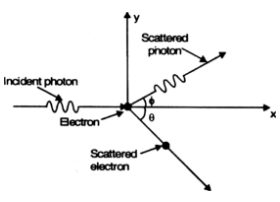 Short Answer Type
Short Answer TypeCompton scattering : This experiment gives experimental verification of particle properties of electromagnetic radiation.
In Compton scattering, a homogenous beam of X-rays wave incident on a light element, the X-rays suffered a change of frequency on scattering. The scattered beam contained two wavelengths.
(i) One scattered beam had the same wavelength as the incident beam.
(ii) The second beam had a wavelength longer than that of incident beam. This change of wavelength is due to loss of energy of incident X-rays due to elastic interaction and is called Compton scattering.
Conclusion :
(i) The increase in wavelength does not depend on the wavelength of the incident photon or the nature of the scatterer.
(ii) The increase in wavelength depends only on the angle of scattering Φ.
(iii) It gives experimental proof of particle nature of electromagnetic radiation.
(iv) It provides verification of quantum theory.
The threshold wavelength of tungsten is 2400 Å.
When tungsten is illuminated with light of wavelength 1600 Å, find :
(i) Work function
(ii) Maximum kinetic energy of the emitted electron
(iii) Stopping potential.
